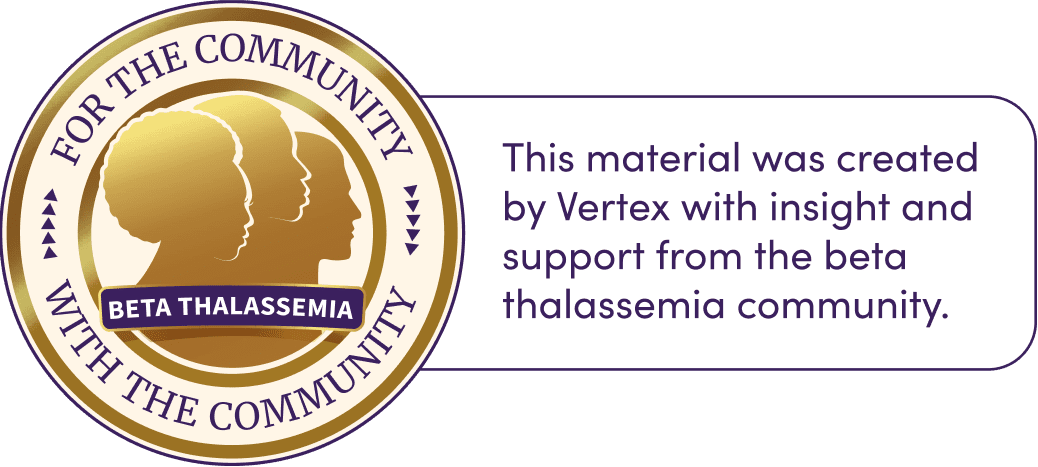IMPORTANT SAFETY INFORMATION
What is the most important information I should know about CASGEVY?
After treatment with CASGEVY, you will have fewer blood cells for a while until CASGEVY takes hold (engrafts) into your bone marrow. This includes low levels of platelets (cells that usually help the blood to clot) and white blood cells (cells that usually fight infections). Your doctor will monitor this and give you treatment as required. The doctor will tell you when blood cell levels return to safe levels.
- Tell your healthcare provider right away if you experience any of the following, which could be signs of low levels of platelet cells:
- severe headache
- abnormal bruising
- prolonged bleeding
- bleeding without injury such as nosebleeds; bleeding from gums; blood in your urine, stool, or vomit; or coughing up blood
- Tell your healthcare provider right away if you experience any of the following, which could be signs of low levels of white blood cells:
You may experience side effects associated with other medicines administered as part of the treatment regimen with CASGEVY. Talk to your physician regarding those possible side effects. Your healthcare provider may give you other medicines to treat your side effects.
How will I receive CASGEVY?
Your healthcare provider will give you other medicines, including a conditioning medicine, as part of your treatment with CASGEVY. It’s important to talk to your healthcare provider about the risks and benefits of all medicines involved in your treatment.
After receiving the conditioning medicine, it may not be possible for you to become pregnant or father a child. You should discuss options for fertility preservation with your healthcare provider before treatment.
STEP 1: Before CASGEVY treatment, a doctor will give you mobilization medicine(s). This medicine moves blood stem cells from your bone marrow into the blood stream. The blood stem cells are then collected in a machine that separates the different blood cells (this is called apheresis). This entire process may happen more than once. Each time, it can take up to one week.
During this step, rescue cells are also collected and stored at the hospital. These are your existing blood stem cells and are kept untreated just in case there is a problem in the treatment process. If CASGEVY cannot be given after the conditioning medicine, or if the modified blood stem cells do not take hold (engraft) in the body, these rescue cells will be given back to you. If you are given rescue cells, you will not have any treatment benefit from CASGEVY.
STEP 2: After they are collected, your blood stem cells will be sent to the manufacturing site where they are used to make CASGEVY. It may take up to 6 months from the time your cells are collected to manufacture and test CASGEVY before it is sent back to your healthcare provider.
STEP 3: Shortly before your stem cell transplant, your healthcare provider will give you a conditioning medicine for a few days in hospital. This will prepare you for treatment by clearing cells from the bone marrow, so they can be replaced with the modified cells in CASGEVY. After you are given this medicine, your blood cell levels will fall to very low levels. You will stay in the hospital for this step and remain in the hospital until after the infusion with CASGEVY.
STEP 4: One or more vials of CASGEVY will be given into a vein (intravenous infusion) over a short period of time.
After the CASGEVY infusion, you will stay in hospital so that your healthcare provider can closely monitor your recovery. This can take 4-6 weeks, but times can vary. Your healthcare provider will decide when you can go home.
What should I avoid after receiving CASGEVY?
- Do not donate blood, organs, tissues, or cells at any time in the future
What are the possible or reasonably likely side effects of CASGEVY?
The most common side effects of CASGEVY include:
- Low levels of platelet cells, which may reduce the ability of blood to clot and may cause bleeding
- Low levels of white blood cells, which may make you more susceptible to infection
Your healthcare provider will test your blood to check for low levels of blood cells (including platelets and white blood cells). Tell your healthcare provider right away if you get any of the following symptoms:
- fever
- chills
- infections
- severe headache
- abnormal bruising
- prolonged bleeding
- bleeding without injury such as nosebleeds; bleeding from gums; blood in your urine, stool, or vomit; or coughing up blood
These are not all the possible side effects of CASGEVY. Call your doctor for medical advice about side effects. You may report side effects to FDA at 1-800-FDA-1088.
General information about the safe and effective use of CASGEVY
Talk to your healthcare provider about any health concerns.
Please see full Prescribing Information including Patient Information for CASGEVY.















